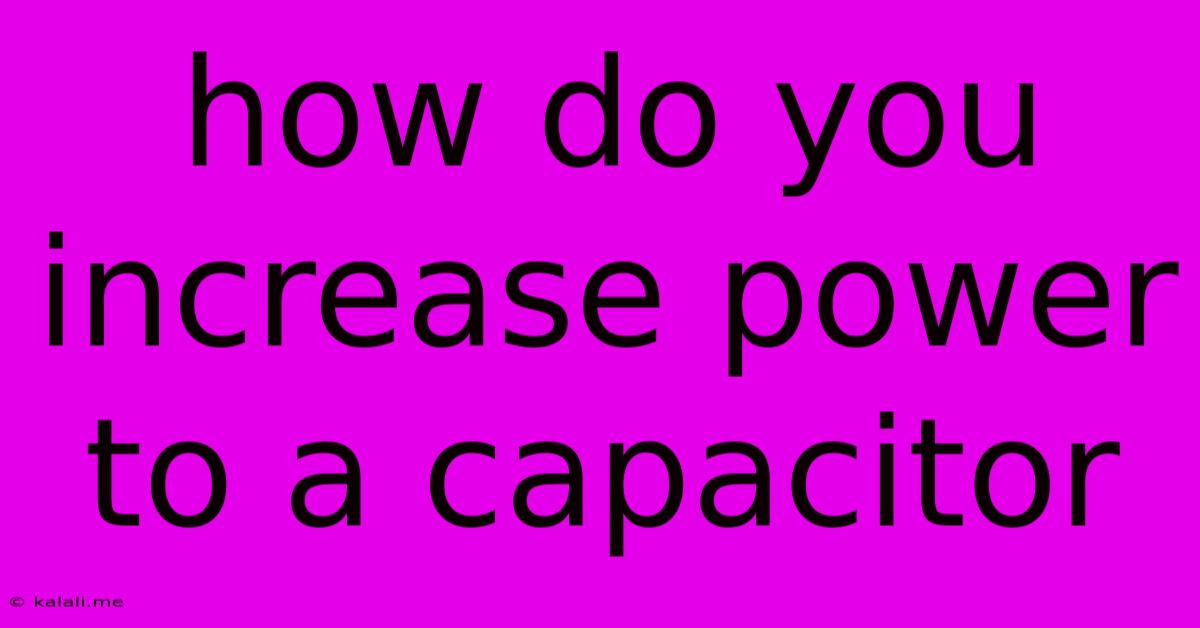How Do You Increase Power To A Capacitor
Kalali
Jun 08, 2025 · 3 min read

Table of Contents
How to Increase the Power Handling of a Capacitor
Capacitors are passive electronic components that store electrical energy in an electric field. While they don't directly "handle" power in the same way as a resistor or transistor, their ability to withstand voltage and current is crucial to their safe and effective operation. Increasing the "power handling" of a capacitor usually refers to enhancing its ability to handle higher voltages and currents without failure. This article explores methods to improve capacitor performance in this context, focusing on both the design and application aspects. Understanding these factors is crucial for preventing capacitor failure and ensuring the longevity of electronic circuits.
Understanding Capacitor Limitations
Before diving into methods of increasing power handling, it's essential to understand what limits a capacitor's capabilities. Key factors include:
- Voltage Rating: Every capacitor has a maximum voltage rating (often denoted as WVDC or VDC). Exceeding this limit can lead to dielectric breakdown, permanently damaging the capacitor.
- Current Rating: While not always explicitly stated, capacitors have limitations on the amount of current they can handle, especially during charging and discharging cycles. High currents can generate excessive heat, potentially leading to failure.
- ESR (Equivalent Series Resistance): The ESR represents the internal resistance of the capacitor. High ESR can lead to increased heat generation and voltage drops, reducing efficiency and potentially causing damage at high currents.
- Capacitance Value: The capacitance itself plays a role. Larger capacitance values generally store more energy, and this energy release can be demanding on the capacitor if it's discharged rapidly.
- Temperature: Operating temperature significantly impacts a capacitor's performance and lifespan. High temperatures accelerate aging and reduce its power handling capability.
Methods to Improve Capacitor Power Handling
Increasing the effective power handling of a capacitor involves several strategies:
- Selecting a Higher-Rated Capacitor: The most straightforward method is to choose a capacitor with a higher voltage rating and a higher current handling capability. This means selecting a capacitor with specifications that exceed the anticipated operating conditions significantly, allowing for a safety margin. Consider parameters like ripple current rating for applications involving alternating current.
- Parallel Capacitor Configuration: Connecting multiple capacitors in parallel increases the overall capacitance and the total amount of charge that can be stored. Crucially, this also distributes the current, reducing the stress on each individual capacitor. This technique effectively increases the power handling capacity of the entire circuit. Remember to ensure all capacitors have similar voltage ratings.
- Series Capacitor Configuration: Connecting capacitors in series increases the overall voltage rating but reduces the total capacitance. This is beneficial when dealing with high voltages but requires careful consideration of voltage distribution across the capacitors to avoid uneven stress. Equalizing resistors are often used to balance voltage across capacitors connected in series.
- Improved Cooling: Excessive heat is a common cause of capacitor failure. Improving cooling, through the use of heat sinks or fans, can significantly extend the lifespan and enhance the power handling of the capacitors. This is particularly important in high-power applications.
- Circuit Design Considerations: Careful circuit design plays a vital role in protecting capacitors. Using appropriate snubber circuits, which are networks designed to suppress voltage spikes, can significantly reduce the stress on the capacitor. Limiting inrush current during capacitor charging with resistors or soft-start circuits also protects the capacitor.
- Using Higher-Quality Capacitors: Higher-quality capacitors, often made with superior materials and tighter manufacturing tolerances, generally exhibit better performance characteristics, including increased power handling capability and longer lifespan. These components may have a higher initial cost but offer long-term benefits.
By understanding the limitations of capacitors and employing these strategies, you can effectively increase their power handling capabilities, leading to more robust and reliable electronic circuits. Remember always to consult the datasheet of your chosen capacitor for detailed specifications and operating guidelines.
Latest Posts
Latest Posts
-
Create Table Mysql If Not Exists
Jun 09, 2025
-
Gf Has Guy In Her Apartment
Jun 09, 2025
-
How To Receive The Holy Ghost
Jun 09, 2025
-
How Long For Tile To Set
Jun 09, 2025
-
Why Does My Cat Knead On Blankets
Jun 09, 2025
Related Post
Thank you for visiting our website which covers about How Do You Increase Power To A Capacitor . We hope the information provided has been useful to you. Feel free to contact us if you have any questions or need further assistance. See you next time and don't miss to bookmark.